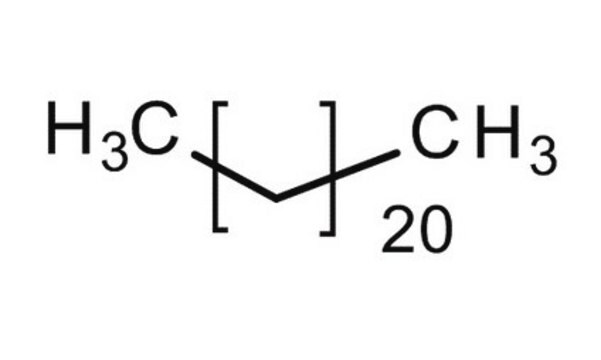8.22265
Chloroform
EMPLURA®
Synonym(s):
TCM, Trichloromethane, Methane trichloride, Methyl trichloride, Methylidyne trichloride, Trichloromethane
About This Item
Recommended Products
vapor density
4.1 (vs air)
Quality Level
vapor pressure
160 mmHg ( 20 °C)
product line
EMPLURA®
Assay
≥99% (GC)
form
liquid
potency
695 mg/kg LD50, oral (Rat)
>3980 mg/kg LD50, skin (Rabbit)
impurities
≤0.1% Water
evapn. residue
≤0.0010%
refractive index
n20/D 1.445 (lit.)
bp
60.5-61.5 °C (lit.)
mp
−63 °C (lit.)
density
1.492 g/mL at 25 °C (lit.)
storage temp.
2-25°C
SMILES string
ClC(Cl)Cl
InChI
1S/CHCl3/c2-1(3)4/h1H
InChI key
HEDRZPFGACZZDS-UHFFFAOYSA-N
Looking for similar products? Visit Product Comparison Guide
Related Categories
General description
Application
- Improved lipid analysis using a 2D-LC-MS system with a novel injection procedure.: This research introduces an advanced lipid analysis method that incorporates chloroform in a dual-dimensional liquid chromatography-mass spectrometry setup, enhancing lipidomic studies′ precision and throughput (Schiell et al., 2024).
- Uncovering the Power of HSCCC: Separation of Diastereomeric and Regioisomeric Styrylpyrones from the Stem Bark of Goniothalamus leiocarpus.: Describes the use of chloroform in high-speed countercurrent chromatography, which is critical for separating complex natural product mixtures (Mu et al., 2024).
- Determination of aflatoxins in rice from Penang, Malaysia by dispersive liquid-liquid micro-extraction and LC-MS/MS.: This study employs chloroform in a dispersive liquid-liquid micro-extraction technique for detecting aflatoxins in rice, highlighting its role in food safety (Ismail et al., 2024).
Analysis Note
Identity (IR): conforms
Density (d 20 °C/ 4 °C): 1.474 - 1.479
Evaporation residue: ≤ 0.0010 %
Water: ≤ 0.10 %
Stabilized with 0,7 - 1,0% Ethanol
Legal Information
Signal Word
Danger
Hazard Statements
Precautionary Statements
Hazard Classifications
Acute Tox. 3 Inhalation - Acute Tox. 4 Oral - Carc. 2 - Eye Irrit. 2 - Repr. 2 - Skin Irrit. 2 - STOT RE 1 Oral - STOT SE 3
Target Organs
Central nervous system, Liver,Kidney
Storage Class Code
6.1D - Non-combustible acute toxic Cat.3 / toxic hazardous materials or hazardous materials causing chronic effects
WGK
WGK 3
Flash Point(F)
does not flash
Flash Point(C)
does not flash
Certificates of Analysis (COA)
Search for Certificates of Analysis (COA) by entering the products Lot/Batch Number. Lot and Batch Numbers can be found on a product’s label following the words ‘Lot’ or ‘Batch’.
Already Own This Product?
Find documentation for the products that you have recently purchased in the Document Library.
Customers Also Viewed
Our team of scientists has experience in all areas of research including Life Science, Material Science, Chemical Synthesis, Chromatography, Analytical and many others.
Contact Technical Service


